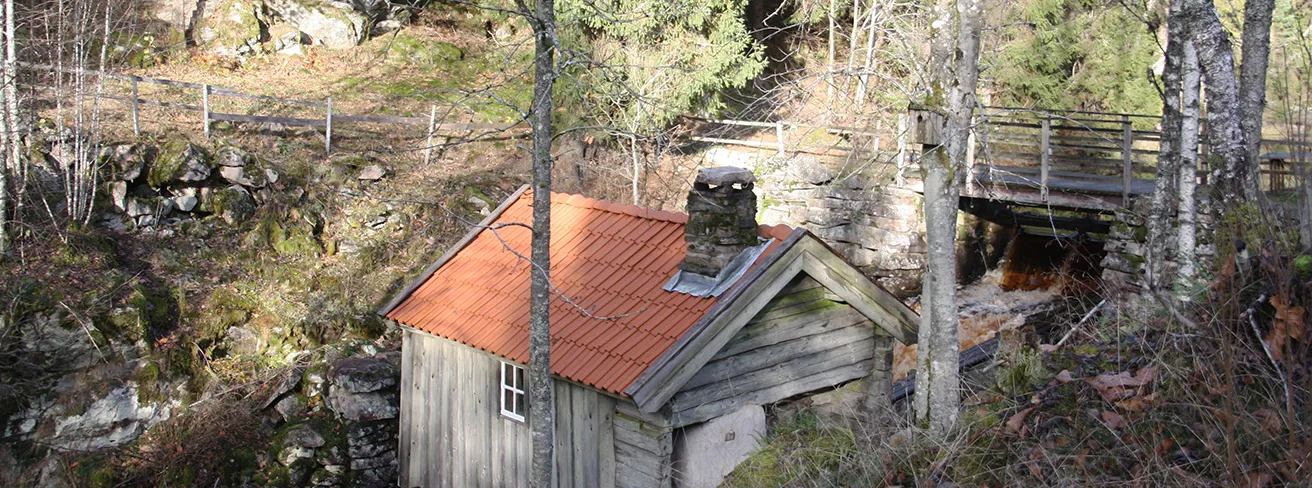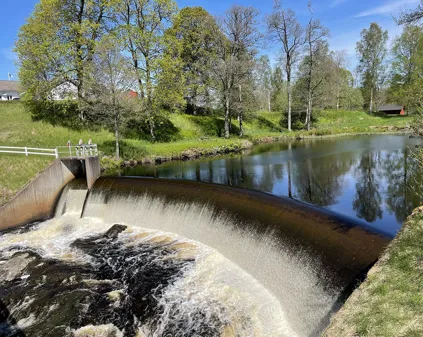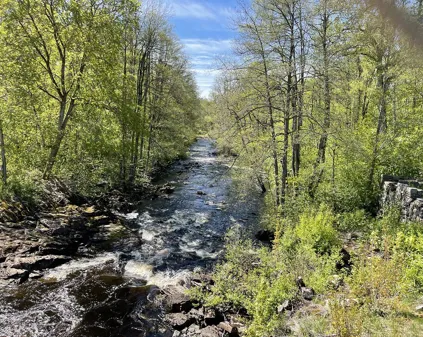
The history along the Nissan river
Learn about timber rafting, mills, sawmills and the ironworks along the Nissan
The river Nissan starts in the highlands of Småland, just southwest of Taberg in a marsh named Nissakälla. There are several different explanations for the river's name, including the river to have been called Niz in Old Swedish times, this is believed to derive from the Latin verb nitere which means shine. There is even a theory that it comes from the word nidh or nidwa which refers to Nissan's dark-coloured marsh water. At 186 km in length, Nissan is one of southern Sweden's longest rivers.
The Nissan river has been a communication route and the lifeblood for transportation, livelihood and settlement throughout history. Fishing has been conducted in the Nissan for as long as people have been moving along the watercourse. Traces from the Iron and Bronze Ages can be found in the northern part of the district and in the Villstad area in the form of burial grounds and burial mounds.
Timber rafting on the Nissan river
Timber rafting has been conducted on the Nissan river since the 17th century. The rafting business expanded in the latter half of the 19th century, when the sawmill industry was expanded and the pulp industry emerged. The rapid development of industry led to the need to organise the rafting along general rafting routes and to prepare the Nissan river with its tributaries. At the peak of Nissan river rafting, the business comprised about five percent of the country's total rafting operations. The total distance of the Nissan river and its tributaries as public rafting routes amounted to 200 kilometres and is thus considered the longest in southern Sweden. In the Nissan river's rafting system within Jönköping County there are still two relatively intact rafting chutes, one at Gyllenfors in Gislaved and a restored one in Valån.


Mills and sawmills
The exploitation of hydropower in the Nissan and its tributaries has a long tradition, with roots stretching back to the Middle Ages. A mill has stood on the outskirts of Skeppshult in Bölaryd since the 17th century and was in use until the late 18th century. The mill took on its current appearance in 1928. It was in commercial operation until about 1960 and was renovated as a museum mill by the Bölaryd mill association in the early 2000s.
Lidernas mill and sawmill can be found in Valdshult parish. The mill was built around 1800. The mill was in use until 1940 and the sawmill was used until 1947, when the water wheel wore out. In 1968, Lidernas mill and sawmill was donated to Valdshults hembygdsförening (local history association), which then began extensive renovation work.
Ironworks and industries along the Nissan river.
Beginning in the 18th century, a number of ironworks began to emerge along the Nissan. Examples of this are Nissafors ironworks, Gyllenfors ironworks and Skeppshult ironworks. Nissafors mill was closed down in 1906. Today, among other things, the iron shed remains, which is beautifully located by the waterfall. Parts of the old works area were converted into a golf course in 1968.
In the late 19th century, Gislaved's rubber factory was founded by the Gislow brothers. At first, they made galoshes. In 1896 they moved their operations to the closed mill in Gyllenfors and during the 20th century they became world leaders in tyre manufacturing.
At Gislaved's industrial museum, located in the old belting factory built in 1935, you can learn about the area's fascinating industrial history. At the museum you will also find the Nissan Culture Trail, which is a pedestrian path dotted with information signs indicating the region’s history.
The Nissan river as a bringer of health
Villstad Brunn- & Badanstalt was established as a wells and health resort in 1852. However, the spring is mentioned earlier, by Carl Linnaeus, who in an account from 1734 described the spring as one of fifteen known springs of "sour wells". The water was drunk to combat a number of diseases such as gout and rheumatism, numbness of joints, stomach acid, mucus diseases, haemorrhoids, fistulas, leg ulcers, tendonitis, jaundice, colds, rashes, upset stomachs, hip pain. In addition to drinking water, spa guests could take a hot dip. The water was taken out of the Nissan river and heated in large pots and then poured into bathtubs on the beach. During the wells period, there were several buildings and a croquet lawn here. Today, only a small well house remains above one of the springs, as well as an information board managed by Villstad local history association.